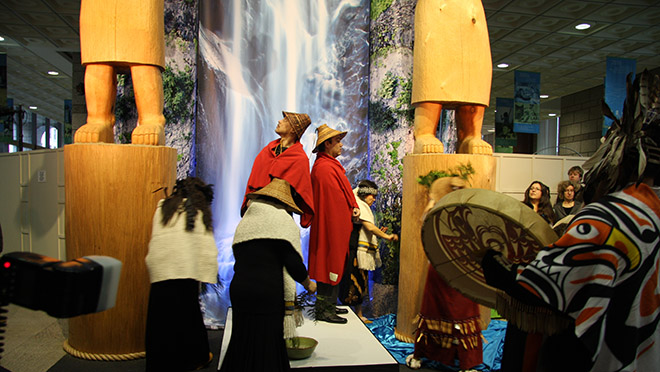 Welcome Figures carvers during the Coast Salish unveiling ceremony in February, 2010
Welcome Figures carvers during the Coast Salish unveiling ceremony in February, 2010
Have you ever seen an Indigenous artwork and wondered about the story behind it?
As we celebrate National Indigenous Peoples Day this year, we're taking a special look at some of the Indigenous Art at our facilities and sharing the stories behind each piece.
Art is a form of storytelling for Indigenous communities that conveys deep cultural meanings and community experiences. Often the work of Indigenous artists can be a form or resistance or healing.
To mark National Indigenous Peoples Day this year, we're acknowledging the deep-rooted histories, culture and contributions of First Nations through the lens of Indigenous Art. Over the years we've commissioned and been given a number of First Nations artworks. These pieces are far more than decorative—they carry deep meaning, rooted in the land, stories and traditions of the people who created them, and they illustrate our journey together toward reconciliation.
Dunsmuir Welcome Figures
If you've ever visited our corporate headquarters at Dunsmuir in downtown Vancouver, you've likely walked past two large welcome figures in the main lobby. With their outstretched arms, the carvings display a traditional Coast Salish symbol of welcome. Welcome Figures were traditionally erected outside the entrance of a Coast Salish community, signaling to visiting people, with their outstretched arms free of weapons, that they were welcome to enter as guests.
These Welcome Figures were first unveiled ahead of the 2010 Vancouver Olympic and Paralympic Winter Games. They were designed and carved by then-employee George Hemeon, a member of the Squamish Nation, under the direction of lead carver Sean Hinton, a descendant of the Cherokee Nation.
Chief Ian Campbell, who was the Chief of Squamish Nation at the time presided over a traditional Coast Salish unveiling ceremony that included prayers, the calling of Witnesses, blanketing, brushing of the posts with cedar boughs, song and dance. During the ceremony he shared that the poles, "are a symbol of the strength and vows of the male and female coming together to bring harmony to the land and to each and every one of us."
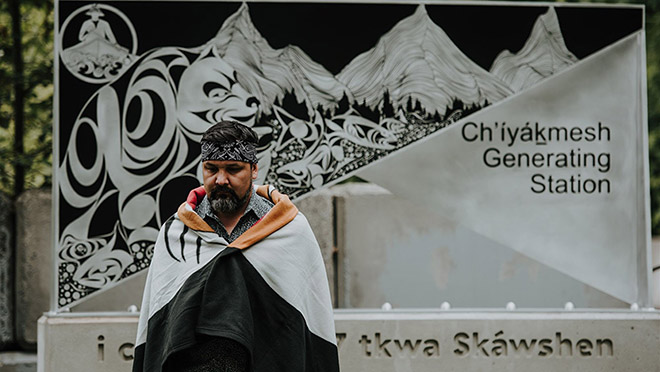 A sign designed by Squamish Nation Coast Salish artist Cory Douglas.
A sign designed by Squamish Nation Coast Salish artist Cory Douglas.
Cheakamus art installation
Visitors to the Cheakamus Generating station in the Squamish-Lillooet area will be greeted with a piece of Squamish Nation culture and history. A sign designed by Squamish Nation Coast Salish artist Cory Douglas depicts a river canoe travelling down a river plentiful with salmon, while grizzly bears fish, surrounded by forests and mountains in a Coast-Salish design honouring the Squamish Nation’s ancestors. The sign also features the Squamish language and village names.
Our Cheakamus system, like other facilities and infrastructure around the province, is located on the traditional territory of Indigenous Nations and the Cheakamus Generating Station was built on Skawshen, a former Squamish Nation village. "This is a very creative way to bring a form of reconciliation between BC Hydro and Squamish Nation," Cory said at the Blessing Ceremony for the new sign. "Activating artists helps to bring cultural contributions to projects and landscapes and brings a greater commitment beyond just the art itself, because it strengthens the relationship with the community."
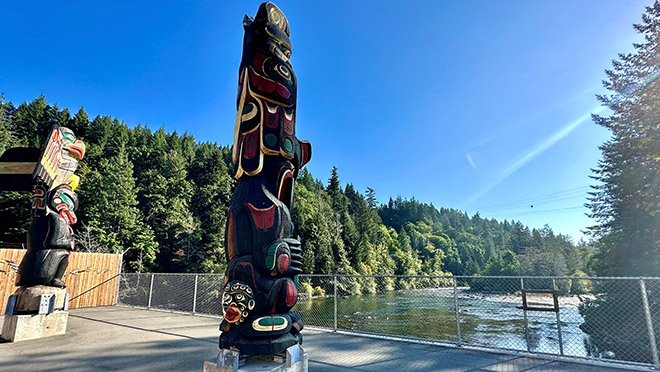 Wei Wai Kai and Wei Wai Kum totems looking out over the water.
Wei Wai Kai and Wei Wai Kum totems looking out over the water.
Wei Wai Kai and Wei Wai Kum poles
At our John Hart generating station in Campbell River, visitors will be welcomed by two totems that were installed to mark our relationship with Wei Wai Kai and Wei Wai Kum First Nations.
The Wei Wai Kum totem was carved in 2019 by Thomas D. Hunt, an artist from the Wei Wai Kum Nation, along with his assistant Ray Shaw. The thunderbird, bear, salmon, and human bubble man totem is represents history passed to Thomas' parents Mary Hunt and George Hunt Sr.
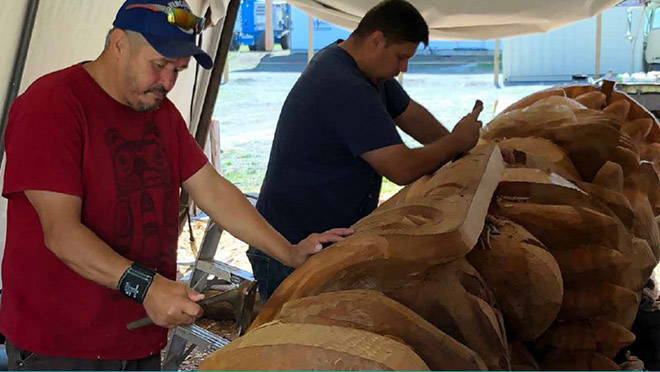 Thomas (left) and Ray (right) carving the totem.
Thomas (left) and Ray (right) carving the totem.
The Wei Wai Kai totem was carved in 2019 by Max Chickite, a Likwiltok artist from the Nation. The eagle represents the power of the sky, the bear represents the power of the land; and the salmon which both eagle and bear live off. The Sea Serpent represents positive or negative, truth or lies.
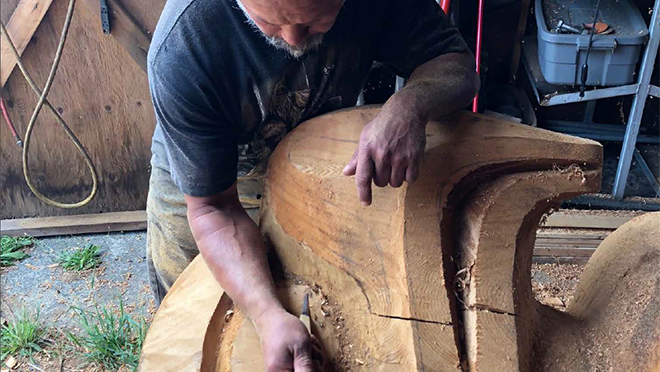 Max carving the Wei Wai Kum totem.
Max carving the Wei Wai Kum totem.
Spend time with Indigenous stories and traditions this month
Since June is also National Indigenous History Month, it's a great time to learn and deepen our understanding of the histories, voices and richness of Indigenous cultures. Read a book by an Indigenous author on a topic related to Indigenous history and culture. You can also engage with art by listening to music by Indigenous songwriters.
However you choose to engage with it, let Indigenous art and culture teach, move and inspire you this month. Celebrating Indigenous art is a way to honour the creativity and resilience of Indigenous peoples, and to make sure that their stories continue to be seen, heard and valued.